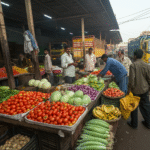Sabji Mandis in Delhi: Life, Color, and the Daily Rhythm of a City
Step into a sabji mandi in Delhi and you’ll feel it right away—the pulse of the city. Crates of tomatoes gleam under tarps, vendors shout rates in a practiced rhythm, scooters weave through narrow lanes, and the scent of coriander and ripe mango hangs in the air. These markets are more than places to buy vegetables. They’re living institutions that power kitchens, shape diets, preserve traditions, and connect people across neighborhoods and income levels.
Why Sabji Mandis Matter
- Cultural anchors: Families have “their” vendors, often for generations. Recipes start with what’s fresh at the mandi that week. Festivals—Diwali, Eid, Navratri—show up in the produce: stacks of pumpkins, fragrant bananas, mountains of leafy greens.
- Economic engines: From farmers and commission agents to porters, cart-pullers, and hawkers, the sabji mandi supports a vast, informal workforce.
- Food security: Mandis keep prices competitive and supply steady across the city. Even with modern supermarkets and apps, most Delhi households still rely on these markets for freshness and affordability.
The Produce: Variety You Can See, Smell, and Taste
Walk any Delhi mandi and you’ll find seasonal abundance:
- Winter: Cauliflower, carrots, peas, methi, sarson, red radishes, kinnow.
- Summer: Mangoes (Dusseri, Langra, Safeda), okra, cucumber, lauki, watermelon.
- Monsoon: Gourds galore, colocasia (arbi), corn, and leafy greens.
- All year: Tomatoes, onions, potatoes, chilies, coriander, garlic, ginger.
You’ll also spot regional specialties—Kashmiri nadru (lotus stem), hill greens, and imported fruits in higher-end markets.
Three Iconic Mandis to Know
1) Azadpur Mandi: Asia’s Produce Powerhouse
- What it is: One of Asia’s largest wholesale fruit and vegetable markets. It’s the city’s heartbeat for supply, with trucks arriving from Punjab, Haryana, UP, Rajasthan, and beyond.
- What you’ll see: Predawn auctions, mountains of onions and potatoes, forklifts and handcarts in constant motion. Prices here ripple across the city.
2) Okhla Sabji Mandi: South Delhi’s Bustling Wholesale Hub
- What it is: A major wholesale and retail market in South Delhi, serving both local neighborhoods and large commercial clients.
- What you’ll see: Wide lanes lined with fresh produce, early morning activity as vendors and buyers haggle, and a diverse mix of regional fruits and vegetables.
- For shoppers: Accessible for both bulk buyers and everyday families. Early visits mean fresher choices and better bargains.
3) Keshopur Sabji Mandi: West Delhi’s Farming Gateway
- What it is: Key mandi supplying West Delhi and surrounding areas, known for its direct connections with local farmers from Haryana and Punjab.
- What you’ll see: Trucks unloading farm-fresh vegetables, energetic bargaining scenes, and a vibrant mix of local shoppers and restaurant buyers.
- For shoppers: Great for seasonal veggies at competitive prices. The mandi’s scale and farmer links ensure steady supply.
4) Ghazipur Sabji Mandi: Eastern Entry Point
- What it is: Strategically located near the Uttar Pradesh border, Ghazipur manages a significant chunk of Delhi’s incoming veggie traffic.
- What you’ll see: Lines of produce trucks, lively action even before dawn, and a distinctly local vibe in both stalls and crowd.
- For shoppers: Best for bulk deals, and an ideal destination for exploring the less touristy side of Delhi’s vegetable trade. Early mornings offer the biggest variety and best freshness.
- For shoppers: It’s mainly wholesale, but retail buyers can snag bulk deals if they’re early and willing to navigate the chaos. Bring cash, small notes, and a sturdy bag. Expect crowds.
The Atmosphere: Organized Chaos with a Human Touch
- Soundscape: Price calls, bargaining chatter, and the clatter of crates.
- Movement: Porters with headloads, carts threading gaps, bikes idling at stall edges.
- Ritual: Regulars greet “apna bhaiya,” ask what’s good today, and get a handful of free coriander to finish the deal.
- Senses: Earthy smells after a spray-down, bright colors piled high, and the snap of a fresh bean when a vendor proves it’s tender.
Challenges on the Ground
- Price swings: Weather events, fuel costs, and supply disruptions can move onion or tomato prices overnight. Vendors manage slim margins; shoppers feel the spikes.
- Perishability: Heat and humidity can wilt produce fast. Limited cold storage means waste rises on hot days, pushing prices up.
- Crowds and congestion: Narrow lanes, peak-hour traffic, and limited parking add stress for everyone. It’s worse around festivals.
- Cash flow and digital access: Cash still dominates, though QR payments are growing. Small vendors juggle credit and daily cash needs.
- Regulatory and infrastructure gaps: Waste disposal, drainage, and sanitation vary by market, affecting hygiene and comfort.
How Vendors and Shoppers Cope
- Timing: Vendors offload early to avoid heat losses; seasoned shoppers arrive morning or late evening for best freshness and prices.
- Relationships: Regular customers get better picks, a little extra (dhaniya, green chilies), and sometimes early notice of price changes.
- Diversification: Some vendors add cut produce, herbs, or fruits to hedge risk; others join delivery apps or WhatsApp groups for repeat orders.
- Micro-innovations: Shade nets, spray misters, insulated crates, and digital scales help quality and trust.
Tips for First-Time Visitors
- Go early or late: Aim for 7–9 AM or after 6 PM. Midday is hot and crowded.
- Carry cash and a tote: Small notes speed things up. A sturdy bag saves you from flimsy plastic.
- Buy with your eyes and hands: Look for firm texture, bright color, and natural scent. Avoid bruises and excess moisture.
- Ask “aaj kya taza hai?”: Vendors will point you to what’s peak that day. Seasonal buys taste better and cost less.
- Compare before you commit: Prices vary stall to stall. Walk a lane, then circle back.
- Be polite but firm when bargaining: Start a bit below the quoted price and meet in the middle. Smile—it helps.
- Mind your step and space: Watch for carts and spills. Keep to the side when you stop.
- Keep perishables cool: Bring an insulated bag if you’re buying leafy greens or dairy from nearby stalls.
- For Azadpur: Wear closed shoes, keep valuables secured, and consider going with a local or porter if buying in bulk.
- For INA: Expect cleaner aisles and a touch higher prices; great if you want variety and convenience.
- For Chhatarpur: Early mornings offer the best farm-fresh options and quicker in-and-out.




